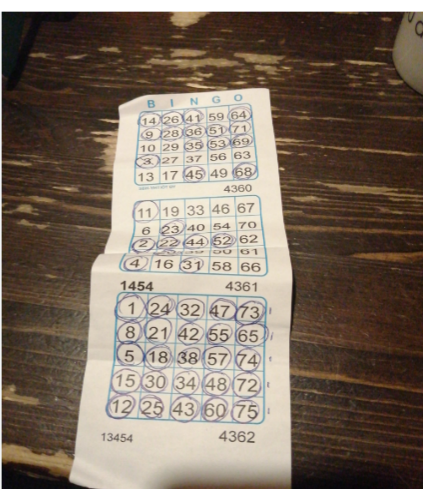The odds vary based on card distribution and player count, but they are significantly lower than with more calls.
Introduction to Bingo and Its Popularity
Bingo is a captivating game that has managed to maintain its charm across centuries. The game underwent several changes as it moved from Italy to France and finally reached the shores of America.

Brief history of the game
Bingo, as we know it today, owes much of its current form to a man named Edwin S. Lowe. In 1929, while traveling through Georgia, Lowe came across a carnival where people were playing a game called “Beano.” Players used dried beans to mark their cards, shouting “Beano!” when they won. Intrigued by the game’s potential, Lowe brought the idea back to his hometown, New York, where he modified the rules slightly and renamed it “Bingo.” More about Edwin S. Lowe on Wikipedia.
Within a few years, the game spread like wildfire. Churches and community centers adopted it as a means of fundraising, contributing to its widespread acceptance and popularity.
Rules and basic gameplay
At its core, Bingo is a game of chance. The central space is often a “free” space.
The game begins when a caller starts drawing numbers at random. The primary objective is to form a specified pattern, often a straight line either horizontally, vertically, or diagonally.
There are various versions of Bingo, each with slight variations in rules. For instance, the UK version uses a 3×9 grid, and the goal is to complete one, two, or all three lines. UK Bingo rules on Wikipedia.
Bingo has proven itself as more than just a game. It’s a social experience that brings communities together, and its simplicity ensures that people of all ages can enjoy it. The game’s low cost – with cards often priced less than $5 – makes it accessible to many, and the thrill of potentially winning significant sums adds to its allure. The average duration of a Bingo game is around 4-5 minutes, ensuring players remain engaged and excited throughout.
With the rise of the internet, online Bingo has also seen a surge in popularity, offering players the chance to play anytime, anywhere. The game’s adaptability and enduring charm guarantee its place in the hearts of many for years to come.
Understanding the Basics of Probability in Bingo
Probability plays a central role in games of chance like Bingo. Essentially, it gives an understanding of how likely an event is to happen, expressed as a ratio or percentage. When it comes to Bingo, grasping the probability can help players make informed choices, anticipate outcomes, and better appreciate the nuances of the game.
Fundamental principles of probability
Probability is the measure of the likelihood of an event occurring. The result is a value between 0 and 1, where 0 indicates impossibility and 1 indicates certainty. Expressed as percentages, these values range from 0% to 100%.
How numbers are drawn and their significance
Traditionally, Bingo numbers are drawn using a random mechanism like a rotating drum containing balls numbered from 1 to 75 (or 90, depending on the version).
So, after the first number, the probability of drawing any specific number becomes 1/74, then 1/73, and so on. This changing probability highlights the dynamic nature of the game.
This unpredictability is what makes Bingo so thrilling.
With more cards in play, the chances of a player winning increase, but so do the variables, making the game’s outcome more unpredictable.
In conclusion, understanding the basic probability in Bingo doesn’t guarantee a win but offers a deeper appreciation of the game’s intricacies. With each number drawn, the anticipation builds, all thanks to the simple yet profound principles of probability. More about probability on Wikipedia.

Calculating the Odds of Getting Bingo in 24 Numbers
Bingo, at its core, is a game of probabilities. As players eagerly mark off numbers on their cards, many wonder about their chances of winning within a set number of draws, such as 24. To answer this question, we delve into mathematics, taking into account factors like the number of cards in play, the total numbers in the game, and the patterns required for a win.
Mathematical approach to determining the odds
To determine the odds of winning Bingo in 24 numbers, we start by considering a single card in a standard 75-number game. The card has 24 numbers (with the center space being free), and we’re trying to find out the likelihood of any 5 of those numbers aligning in a row, column, or diagonal within the first 24 draws.
For the first number on a player’s card, the odds of it being drawn are 24/75. Once that number is drawn, the odds of the next number on the player’s card being drawn is 23/74, then 22/73, and so forth.
The combined probability of two specific numbers being drawn consecutively would be: �=2475×2374
But since we are considering any 5 numbers in a row, column, or diagonal within 24 draws, the math gets a bit more intricate, involving combinations and permutations.
Real-world scenarios and examples
Let’s consider a real-world example to illustrate. Imagine a Bingo hall filled with 100 players, each holding a single card.
If the game’s goal is a simple one-line Bingo, and you are aiming to achieve that within 24 numbers:
- After the first draw, you have a 24/75 chance that one of your numbers is called.
- By the 24th draw, several of your numbers would likely have been called, but the odds of them forming a straight line (horizontally, vertically, or diagonally) depend on the distribution of your numbers and the sequence of the draw.
In reality, multiple players might be close to winning, increasing the competition. This dynamic makes it hard to provide a precise figure on the odds without specific card distributions and patterns. But what is certain is that with each number called, the excitement and unpredictability of the game surge.
While mathematics can provide insights, the charm of Bingo lies in its unpredictability. Every game is a new opportunity, a blend of strategy, chance, and hope. For those interested in diving deeper into the probabilities and combinatorics of Bingo, resources like Wikipedia’s page on combinatorics can offer more in-depth information.
Factors that Affect the Odds in Bingo
While Bingo remains a game of chance, various factors influence the odds of winning. These factors can make a significant difference in the outcomes of individual games and, over time, impact a player’s overall success rate. By understanding these variables, players can make more informed decisions and better appreciate the intricacies of Bingo.
The role of the bingo card layout
Each Bingo card is a unique combination of numbers. In the standard 5×5 grid used in the 75-ball version, the arrangement and distribution of numbers play a crucial role in determining the odds of forming a winning pattern.
- Number distribution: Cards with a balanced distribution of numbers across the range (e.g., from 1 to 75) may have a slightly better chance of getting numbers called compared to cards clustered around specific number ranges.
- Pattern placement: The positioning of numbers can also impact the odds. For instance, numbers located centrally on the card might contribute to more potential winning patterns (lines, both vertical and horizontal, and diagonals) than those on the edges.
- Duplicate cards: In some settings, especially in smaller Bingo games or when using pre-packaged sets, players might end up with duplicate cards. In such scenarios, the odds don’t change per se, but multiple winners can result in divided prizes.
Number of players in the game
The number of active players in a Bingo game can significantly affect an individual’s chances of winning:
- More Players, Tougher Competition: With more cards in play, the likelihood of someone achieving Bingo quickly increases. If there are 100 players, the chances of one of them getting Bingo before you are considerably higher than if there were just ten players.
- Prize implications: While a game with more players might reduce individual winning odds, it often means a larger pot or prize due to increased ticket sales or entry fees.
- Strategy implications: In games with a large number of players, some individuals choose to play with multiple cards to increase their chances of winning. This strategy, while increasing the odds of winning for that player, also requires more concentration and can be costlier.
In conclusion, while the core of Bingo revolves around luck, understanding the factors affecting the odds can enhance the playing experience. Players can employ strategies, choose games wisely, and enjoy the thrill of the game with deeper insights. For those interested in the mathematical aspects of probability and game theory, the Wikipedia page on game theory can be an excellent resource to delve into.
Comparing Odds: 24 Numbers Versus Other Scenarios
Bingo’s allure lies in its unpredictability and the thrill of chance. While the odds of achieving Bingo in 24 numbers hold particular intrigue, it’s just one scenario among many. Let’s compare the odds in this situation with other possible scenarios and see how the game’s dynamics change as it progresses.
Odds with fewer or more numbers
- Fewer Numbers: The odds of achieving Bingo with fewer than 24 numbers are, understandably, lower. For instance, getting a Bingo in the first 5 calls is extremely rare, as it means the initial numbers called must perfectly align with a row, column, or diagonal on your card.
- More Numbers: As the game progresses and more numbers are called, your odds of achieving Bingo increase. However, remember that as your odds increase, so do the odds for every other player.
- The Optimal Range: There’s an optimal range where the odds are most favorable, typically somewhere in the middle of the game. However, pinpointing this exact range requires a deep dive into probability theory and factors like card distribution, player count, and more.
How odds change as the game progresses
- Early Game Dynamics: In the early stages, with fewer numbers called, the game tends to be more relaxed. Players are less likely to be close to achieving Bingo, and the anticipation builds gradually.
- Mid-Game Shifts: As the game approaches its middle, there’s a palpable shift. With each call, more players find themselves on the brink of victory. This phase sees the most dramatic changes in odds, with players frequently just one number away from winning.
- Late Game Tensions: In the final stages, the majority of players are often a mere one or two numbers short of shouting ‘Bingo!’. The odds of multiple players achieving Bingo simultaneously increase, leading to shared prizes or tiebreakers.
It’s essential to understand that while mathematical probabilities can offer insights, the real essence of Bingo is its inherent unpredictability. No two games are the same, and that’s what keeps players coming back for more. For those who enjoy the mathematical side of games and want to dive deeper into the world of probabilities, Wikipedia’s page on probability theory offers a treasure trove of information.

